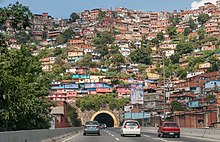
A shanty town, squatter area, squatter settlement, or squatter camp is a settlement of improvised buildings known as shanties or shacks, typically made of materials such as mud and wood, or from cheap building materials such as corrugated tin sheets. A typical shanty town is squatted and in the beginning lacks adequate infrastructure, including proper sanitation, safe water supply, electricity and street drainage. Over time, shanty towns can develop their infrastructure and even change into middle class neighbourhoods. They can be small informal settlements or they can house millions of people.
First used in North America to designate a shack, the term shanty is likely derived from French chantier (construction site and associated low-level workers' quarters), or alternatively from Scottish Gaelic sean (pronounced [ʃɛn]) meaning 'old' and taigh (pronounced [tʰɤj]) meaning 'house[hold]'.
Globally, some of the largest shanty towns are Ciudad Neza in Mexico, Orangi in Pakistan and Dharavi in India. They are known by various names in different places, such as favela in Brazil, villa miseria in Argentina and gecekondu in Turkey. Shanty towns are mostly found in developing nations, but also in the cities of developed nations, such as Athens, Los Angeles and Madrid. Cañada Real is considered the largest informal settlement in Europe, and Skid Row is an infamous shanty town in Los Angeles. Shanty towns are sometimes found on places such as railway sidings, swampland or disputed building projects. In South Africa, squatter camps, often referred to as "plakkerskampe", directly translated from the Afrikaans word for squatter camps, often starts and grows rapidly on vacant land or public spaces within or close to cities and towns, where there may be nearby work opportunities, without the cost of transport.